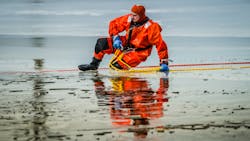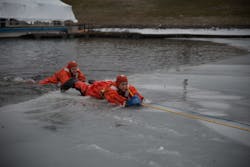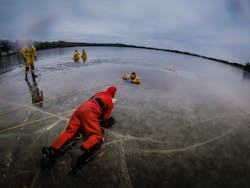Ice rescue has been performed hundreds, if not thousands, of times across the United States and around the world. Ice rescues of civilians, animals and, sometimes, rescuers appear regularly on news outlets during the winter months.
In fact, the regularity of news coverage can make ice rescue appear to be a routine rescue that uses standard techniques and equipment. However, ice rescue can, and will be, very dangerous. The dynamic elements that surround it can lead to disastrous results if those elements aren’t considered during the ice rescue size-up.
Assuming ice is strong
One of the most prevalent dangers to civilians and firefighters alike is the strength and stability of the ice. Many times, civilians assume that the ice is strong enough for them to walk on or use for recreational purposes. Firefighters sometimes can assume that if the ice is strong near the shoreline that it should be relatively strong enough to support their weight while they make their way out to a victim. However, given the dynamic nature of ice development, this assumption can lead civilians and rescuers into trouble.
If you look across a sheet of ice, it might appear smooth and to be a stable platform to walk straight across, similar to a sheet of ice that is in a hockey rink. This particularly can be true when the ice first develops. Ice starts to form at the top layer of a body of water once the water becomes exothermic—about 39.2 degrees F. That top layer of ice can appear very solid.However, as ice develops, many factors contribute to the development. The ice develops thinner on its underside compared with on the top side. This development can be affected by such things as springs that come into the water from the bottom of a pond or lake; by waterfowl that spend part of their day or night on the water; by groups of fish that migrate to one area of a pond or lake; and by water runoff, streams or discharges from hydraulic power plants, etc.
Safe ice
What is safe ice? That is a question that a lot of people can’t answer and that no fire department or public safety entity ever should attempt to answer for the general public. There is a plethora of recommended thicknesses of ice in inches when one does a quick internet search. There even are formulas that are used and taught to determine the bearing capacity of ice. However, the dynamic development of ice always lends to inconsistencies in bearing capacity. When asked, a fire department’s answer regarding safe ice should be, “The only safe ice is in a hockey rink.”
Given these variables in ice development, rescuers always must assume that the ice won’t support the load of possibly themselves, the victim and any equipment that is brought onto the ice. Even though the ice might give the appearance of having the strength of a concrete slab, usually this isn’t the case. For fire departments, this means that they must ensure that they respond with proper PPE that’s available to them.
PPE
A frequent misunderstanding or misapplied use of PPE is when to wear a cold-water/ice rescue suit, also called an exposure suit. The general rule of thumb is that an exposure suit should be worn anytime that the combined air and water temperatures is 120 degrees F or less.
It is critical to wear this type of exposure suit when entering cold water, because the suit will give the rescuer plenty of buoyancy, depending on the type of suit that he/she wears. It also provides thermal protection, given the design to keep heat in. As long as rescuers keep their neck above the surface of the water, they also will be kept dry.
Where the misunderstanding or misapplication can come into play is the subjectivity of the temperatures. For example, if the air temperature is 65 degrees F and the water temperature is 45 degrees F, some rescuers might infer that the suit isn’t needed. In fact, I’ve heard people state that the suit will make them sweat and possibly overheat. Although hypothermia might not occur rapidly, it might affect the rescuer over time.
Another item of PPE that can be misunderstood or misapplied is the personal flotation device (PFD). Within many agencies, there is discussion, even debate, as to when the PFD should be worn at an ice rescue response. The discussion can be that rescuers who are along the shoreline don’t need PFDs, because they are on solid ground and the water is covered in ice. Many cases prove this theory wrong, such as one that occurred in Omaha, NE, several years ago, when rescuers who were helping to pull victims/boats into and along the shoreline fell into the water themselves.
The solution to this: Many organizations throughout the United States developed a standard operating procedure or standard operating guideline that requires that PFDs be worn by all personnel who are within 10 feet of the shoreline. Of course, the distance can be increased or decreased, depending on the target hazards that the community has within its boundaries.
On the other hand, the discussion might be that the PFD is difficult or restrictive when worn with turnout gear. Rescuer safety is paramount and must be considered as the first priority in every type of fire department response, including an ice rescue.
Techniques
As simple and as straightforward as ice rescue might be, there has been debate over the past several decades over the best rescue technique(s) for somebody who fell through the ice. The debates/discussions can include whether it is safer or faster to go from the shoreline, to use a “go method” or to use a helicopter.
There is no one technique that works best for all agencies that could respond to an ice rescue. It comes down to what works best for a particular region, for a particular rescue agency, and for the equipment and training that the department possesses.
For example, there can be a discussion as to whether a go method or a device (sleds, slings, etc.) method works fastest. That all depends on the training and equipment that response agencies have, how often that they practice the technique(s), etc.
“What is the fastest technique to get to a victim in broken ice?” always comes up at the Massachusetts Firefighting Academy. What always is recommended to the person who asks the question is, do a trial between the go method and the device that you have or the product that you are testing to see which is faster in getting out to a simulated victim.Go method
The go method can include transition across the ice by sliding your feet, crawling on all fours or even getting right down on your belly and doing the “G.I. Joe” crawl. If possible, rescuers should approach to the side of a victim as opposed to straight on, where the victim might already have jeopardized the integrity of the remaining ice.
Another misunderstanding: There only is one technique to use each time that a rescue agency responds to an ice rescue—for example, a technique that involves responding from the shoreline or a technique that involves responding via a boat, etc. Nothing could be further from the truth. Depending on the location, a go method might work the best given a victim who isn’t that far from the shoreline. However, if you respond to a large body of water, as is common with most geographical areas, you might need another technique. You might need to use a device, such as an inflatable rescue craft, to serve as a working platform to reach a victim who fell through the ice some distance away from the shoreline.
Every responding agency must examine what techniques are available for ice rescue responses. Each must conduct a needs assessment for its target hazards along with its planning and preparation. An agency should do time trials and practice responses in the target hazards where it seems to go to every year for ice rescue calls. With this information, a rescue agency can determine what techniques work best for the organization to ultimately have a successful outcome, all the while keeping its responders’ safety paramount.
Personnel safety
Maintaining safety for personnel on scene always should be the first consideration. Although this is easy to assume when in training, when an actual response occurs, rescuers can put themselves at risk trying to get to a victim while working off of the emotions of the heart as opposed to the sensibility of the head. This can be from shore team members who aren’t wearing the proper PPE (neoprene gloves or PFDs) to those who are responding on the ice not having PPE properly secured for their own safety and thermal protection.
Sizing up the situation that lies before the first-arriving companies is crucial to a successful outcome. The proper technique(s) given the condition of the victim, the environment and other factors must be determined. Responders must be briefed as to the situation and the rescue techniques that are to be used as well as to safety considerations.
Incident commanders and responders must know their limitations and the limitations of the equipment that they wear. For example, while a rescuer is making his/her way out to a victim in proper PPE, he/she notices that the victim slipped below the surface of the ice. Should the tactic change? The normal reaction of the responder would be to possibly reach, or dive, below the surface of the ice to the victim. However, that isn’t what the PPE is designed for, and the action could put the rescuer in harm’s way.
The tactic would change to that of a dive team response. Given the surface ice rescue equipment that’s available to responders, they can’t go below the surface of the ice/water. This might be a tough pill to swallow for individuals who are in the fire service because of their compassion and their unrelenting can-do attitude. That said, this doesn’t mean that other techniques can’t be attempted while on the surface. However, it must be emphasized that rescuers don’t go below the surface of the water/ice.
The best chance for success
In planning for the worst-case scenario when exercising an ice rescue, a fire department team will have the most successful outcome when the team properly plans and practices for an ice rescue given their known target hazards within their community.
Working through the extremely dynamic environment that is ice rescue, rescuers (and commanders) must overcome complacency, misunderstandings of equipment/techniques and the environment. The responding agency must adjust on the fly, as we always do in the fire service, which gives the person who, unfortunately, fell through the ice the greatest chance of a successful rescue while keeping the first responders safe.
Training Confidence
A common misconception to rescue agencies and personnel is that the ice will be as strong and unforgiving when they respond to an incident as it was when they trained on the same body of water. However, as we know, training normally happens when ice is newly formed and very strong, usually when there are several inches of clear blue or black boilerplate-like ice.
Responses usually happen when the ice weakened because of temperatures rising then froze again or warmed up altogether. This can occur anytime during the ice season and particularly when the spring thaw starts. So, when first responders get the phone call for an ice rescue response, the ice certainly won’t act the same as it did when responders trained. In fact, given weak, honeycomb-looking ice, it might be very difficult to reach a victim and successfully rescue the individual.
Furthermore, personnel hydration, exhaustion and mental well-being must be monitored during the entire incident. The rescuer’s safety is paramount.
About the Author
Mark McCabe
Mark McCabe is a 30-year member of the fire service with experience in fire suppression, hazardous materials, fire prevention and fire instruction. Since 1993, he has been a fire instructor who teaches in all fire service subjects. McCabe specializes in the instruction of technical rescue and currently is the coordinator of Technical Rescue for the Massachusetts Firefighting Academy (MFA). As a current team leader of the Southeastern Massachusetts Technical Rescue Team, he responds to technical rescue incidents within the commonwealth of Massachusetts. For 24 years, McCabe was a rescue specialist and squad officer with FEMA’s Massachusetts Urban Search and Rescue team, having been deployed for incidents from natural disasters to the World Trade Center on 9/11. He is a certified Rescue Technician, Hazardous Materials Technician and EMT, and he holds numerous professional career certifications. McCabe earned his bachelor’s degree in fire science in 2017 and his master’s degree in public administration in 2018, both from Anna Maria College, and completed the Chief Fire Officer Training Program at the University of Massachusetts Edward J. Collins Jr. Center for Public Management in 2019 at the MFA.


